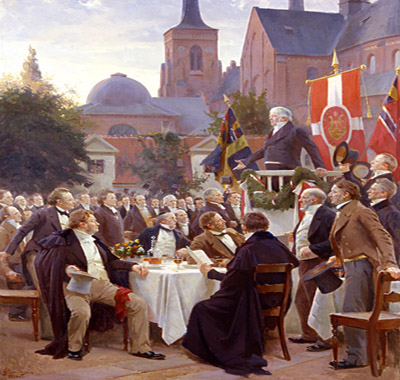| Introduktion

| | 1800-tallet var præget af store opdagelser inden for teknik og naturvidenskab. Det medførte bl.a. industrialiseringens gennembrud med store forandringer indenfor produktion, infrastruktur og livsformer.
Udviklingen var båret af romantiske og nationalliberale strømninger, der bl.a. kom til udtryk i en skandinavistisk bevægelse, som også satte sig spor i kunsten. |
I slutningen af 1700 og starten af 1800-tallet opstår der en bevægelse for skandinavisk samling og enhed, bl.a. ud fra romantikkens forestillinger om sproglig og kulturel enhed, men også som følge af større rejseaktivitet og voksende kulturelle udveksling. Omkiring århundredeskiftet er det fortsat besværligt at krydse Øresund, men efter århundredeskiftet øges samkvemmet betydeligt.
I første omgang er det hovedsagelig litterære og intellektuelle kredse som står for den øgede kontakt, men i løbet af 1800-tallet får bevægelsen i sammenhæng med nationale og liberale strømninger også en vis folkelig og politisk forankring.
De dansk-svenske tilnærmelser beror på en fælles udvikling og kultur for det liberalt orienterede borgerskab, men påvirker også de royale kredse. Forening af de tre nordiske riger diskuteres seriøst, men det harmonerer ikke med de europæiske stormagters ønsker. Danmark står alene da det i starten af 1800-tallet overfaldes af England og storpolitisk indblanding omkring de slesvigske krige i 1848 og 1864 sætter en stopper for bestræbelserne.
Udviklingen af infrastrukturen omkring Øresundsregionen med dampskibe og jernbaner medvirker til at mindske afstanden, også mentalt. Forskelle, men vel især ligheder, bliver mere synlige. Kontakterne over Sundet både mere hyppige og mangeartede og omfatter alle lag i samfundet. Mest synlige er produkterne af den kulturelle udveksling: Monumenter, bygningsværker og gensidig påvirkning indenfor litteratur og malerkunst.
Udviklingen i Nordsjælland rummer specielle udviklingstræk, fordi området også fremstår som rekreativt område for Københavnsregionen. Den fritdskultur der i tidligere tider gjaldt for kongehuset og hoffet, kommer med tiden også til at omfatte embedsadelen og borgerskabet. En tilsvarende udvikling finder sted langs den skånske kyst, ved kurstedet Ramlösa Brunn og med kongefamiliens erhvervelse af Sofiero.
Københavnsområdet udvikler sig fra omkring år 1800 til et dynamisk center i regionen med en eksplosiv befolkningsforøgelse, industriel udvikling og betydelig arealmæssig forøgelse i tiden efter 1857. Arbejdskraft fra det omliggende landbrugssamfundet ikke kun i Danmark, men også store dele af Sydsverige søger mod Københavnsområdet, hvor lønniveauet ofte er dobbelt så højt og levevilkårene generelt bedre.
Udviklingen på den svenske side af Øresund foregår lidt senere, men i løbet af 1880erne tager det fart i Malmø, hvor arbejderbevægelsen bl.a. med erfaringer fra Københavnsområdet også hurtigt vinder fodfæste. I Helsingborg anlægges i 1800-talets senere del en større havn og det bliver starten på en rivende udvikling. Helsingborg er på mange måder førende i udviklingen på Skånesiden og en række af de ledende skikkelser her har rødder i det danske.
Helsingør er med sin tilknytning til Øresundstolden, der først ophæves samme år som Næringsfrihedsloven vedtages i 1857, noget speciel, men også her sætter den industrielle udvikling sig igennem i løbet af 1800-tallet. Helsingør undergår i løbet af 1800-tallet og især efter ophævelsen af Øresundstolden i 1857 og med anlæggelsen af et skibsværft i 1880erne en udvikling, der, næst efter København, gør den til den største industriby på Sjælland. |